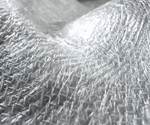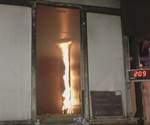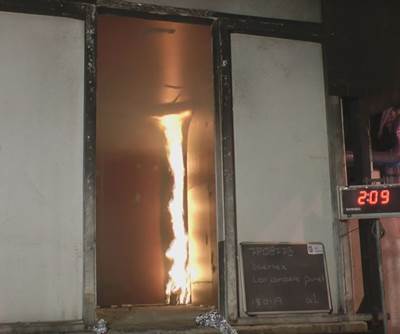TRB develops fire-resistant biocomposite door leaf
The carbon fiber-reinforced biocomposite sandwich panel features a 100% recycled foam core and has been designed for light weight and fire resistance.
TRB Lightweight Structures Ltd. (TRB; Cambridgeshire, U.K.) has developed a new carbon fiber-reinforced biocomposite sandwich panel door leaf with a 100% recycled foam core, specifically designed and fire rated for both overground and underground rail use.
The composite structural system is said to easily pass BS 6853 and BS 476 standards and is EN 45545 HL3 compliant. The product, TRB says, offers a sustainable, “green” composite material option for carriage door leaves at a comparable cost to aluminum bonded door leaves, with a 35% weight saving.
The design and engineering team at TRB has worked closely with a resin partner to develop a new, proprietary carbon fiber-compatible, bio-based prepreg resin. TRB says that the new system had to be highly sustainable, cost-effective to manufacture and lightweight while meeting demanding fire, smoke and toxic fumes (FST) specifications in subterranean rail applications. The new “bio” prepreg, which is non-toxic and does not use volatile organic solvents, is based on a Polyfurfuryl alcohol (PFA) resin derived from a renewable alcohol produced from a natural waste byproduct from refined sugar production.
The biocomposite prepreg system can also be used for other rolling stock parts, TRB says. The foam core used in the rail door leaf composite structure is produced from 100% recycled consumer plastic. It was selected by TRB as the recycled foam core to meet the goal for sustainability, and it delivers the desired overall material properties performance of the sandwich panel construction when used in combination with the woven carbon fiber fabric on both sides and the bio resin prepreg. Other matrix design options for other applications using glass fibers, natural fibers or aramid fibers can be custom made on request, TRB says. Depending on rail customer needs, door leaves are supplied with a gelcoat, finish painted or primed ready to paint.
According to the company, during BS 476 Part 7 testing, the sandwich panel system achieved a Class 1 category 1a rating, with a 30% less recorded flame spread of 50 millimeters in the 1.5 minute test time, compared to the maximum allowable of 165 millimeters for the Class 1a rating. “We are extremely pleased with the overall performance data for the new biocomposite carbon fiber prepreg sandwich panel system, in particular the FST specifications achieved,” says Lyndon Newman, chief engineer for TRB. “In the 30 years I have been in the industry, I have never seen such impressive fire performance test results for a non-phenolic based thermoset system, achieving the BS standard so comfortably. Our PFA bio resin prepreg has fire retardant properties greater than phenolics, plus excellent temperature and chemical resistance.”
Read more about the fire resistance of TRB’s prepreg and other fire-resistant composite materials in “Withstanding fire without the weight”
“We initially developed this biocomposite product for rail door leaves, but it could be used for other mass transport interior applications. We have brought aerospace prepreg technology to our rail customers,” Newman adds.
The door leaf product is said to weigh 26 kilograms, a 35% reduction in weight compared to a 40-kilogram aluminum equivalent. The TRB door leaf is reported to have a 40-year life cycle expectancy, and compared to aluminum, its benefits are said to include more robustness, superior fatigue resistance, low maintenance costs, reduced energy consumption per journey, less track wear and tear, and other cost- and weight-saving benefits.
Related Content
TCR Composites introduces TR1116 snap-cure epoxy prepreg resin system
Designed for press-cure applications, the resin system is highlighted for its snap-cure capability and tailored properties.
Read MoreCarbon fiber, bionic design achieve peak performance in race-ready production vehicle
Porsche worked with Action Composites to design and manufacture an innovative carbon fiber safety cage option to lightweight one of its series race vehicles, built in a one-shot compression molding process.
Read MoreHexcel launches novel RTM resin, rapid-cure prepreg for aerospace
HexPly M51 prepreg and HiFlow HF610F-2 resin add to Hexcel’s delivery of faster cure cycles and thus higher production build rates.
Read MoreMeasuring ply-wise deformation during consolidation using embedded sensors
Strip-type shape sensor method claims real-time measurement of ply-wise deformation.
Read MoreRead Next
Withstanding fire without the weight
New composites meet stringent fire requirements while lightweighting ships, rail cars and battery boxes for electric cars and planes.
Read MoreMeasuring and improving fire resistance in composites
Sidebar to CW’s Feb 2019 feature article, this quick review of fire tests for composites also provides more details about intriguing new material developments.
Read More“Structured air” TPS safeguards composite structures
Powered by an 85% air/15% pure polyimide aerogel, Blueshift’s novel material system protects structures during transient thermal events from -200°C to beyond 2400°C for rockets, battery boxes and more.
Read More
.jpg;width=70;height=70;mode=crop)

























